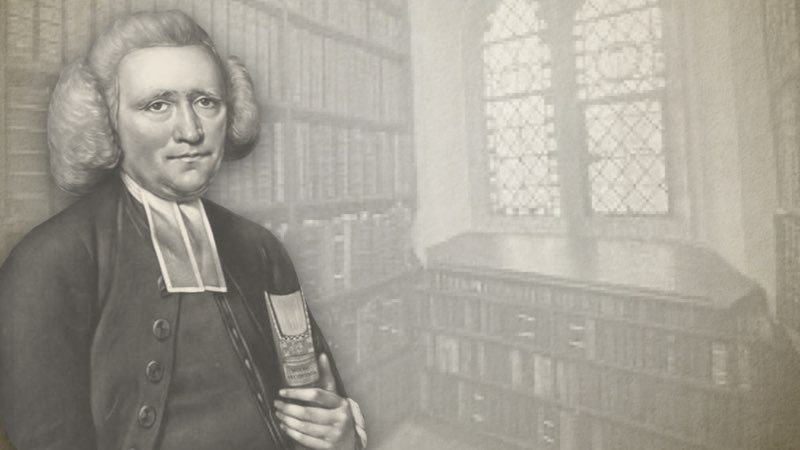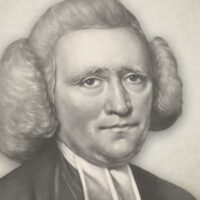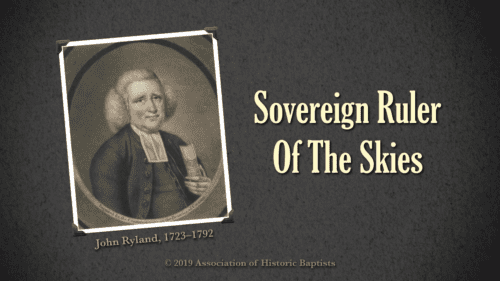
The Life And Ministry Of John Collett Ryland
Dictionary of National Biography, Volume 50, 1897:
John Collett Ryland (1723-1792), divine, son of Joseph Ryland, a farmer and grazier of Lower Ditchford, Gloucestershire, and grandson of John Ryland, yeoman, of Hinton-on-the-Green, Gloucesterhisre, was born at Bourton-on-the-Water in the same county on 12 Oct. 1723. His mother, Free-love Collett, of Slaughter, was a collateral descendant of John Colet, dean of St. Paul’s. Ryland was baptized in 1741 by Benjamin Beddome, who, perceiving him to be a lad of promise, sent him about 1744 to Bernard Foskett’s academy at Bristol to prepare for the ministry. After undergoing much spiritual conflict he left Bristol in 1750 to be pastor of the Baptist church at Warwick, where he had already preached for four or five years. Here he kept school in St. Mary’s parsonage-house, rented of the rector, Dr. Tate, who, when remonstrated with on harboring a dissenter, used to retort that he had brought the man as near the church as he could, though he could force him into it.
In October 1759 Ryland left Warwick for Northampton, where he lived twenty-six years as minister and schoolmaster, his pupils often numbering as many as ninety. Among them was Samuel Baxter. It is his chief merit to have done more perhaps that any man of his time to promote polite learning among the Baptist and orthodox dissenters. Twice his church was enlarged, and in 1781 his son, John Ryland (1753-1825), joined him as co-pastor. On 2 July 1784 he delivered at sunrise over the grace of Dr. Andrew Gifford in Bunhill Fields an “Oration,” which was published (1834 and 1888). In 1786 Ryland resigned to his son the care of the church, and removed his school to Enfield, where it grew and flourished. Ryland frequently preached in the neighborhood. He is said to have once addressed from a coach-box, in a seven-storied wig, holiday crowds assembled on the flat banks of the Lea, near Ponder’s End. He was massive in person, and his voice in singing was compared to the roaring of the sea. The degree of M. A. Was conferred upon him in 1769 by Brown University, Providence, Rhode Island, U.S.A. (Founded 1765).
Ryland died at Enfield on 24 July 1792, and was buried at Northampton, his funeral sermon being preached by Dr. John Rippon. An elegy by “Legatus” was published (London, 1792, 4to.) He was twice married: first, on 23 Dec. 1748, to Elizabeth Frith of Warwick (d. 1779); and secondly to Mrs. Stott, widow of an officer. His sons by his first wife, John (1753-1825) and Herman Witsius, are noticed separately. A portrait by John Russell (1745-1806), in full-bottomed wig and bands, engraved by Granger, is prefixed to his “Address to the Ingenuous Youth of Great Britain,” London, 1792, 12mo.
Ryland’s passion for book-making once or twice involved him in pecuniary difficulties. Neither printer, publisher, nor engraver could turn out their work half fast enough for him. As his friends James Hervey (1714-1758) and Augustus Toplady told him, he would have done more had he done less. With James Ferguson (1710-1776) he issued “An Easy Introduction to Mechanics,” 1768, 8Vo, and “A Series of Optical Cards.” He contributed to the “Baptist Register,” edited by John Rippon, wrote many of the articles fro Buck’s “Theological Dictionary,” London, 1802, 8vo, and edited Edward Polhill’s “Christus in Corde,” Quarles’s “Emblems,” Jonathan Edwards’s “Sermons” (1780), and Cotton Mather’s “Student and Preacher” (1781).”
John Collett Ryland (1723-1792) was a Particular Baptist preacher. In 1741, he was baptized by Benjamin Beddome. In 1750, he became pastor of the Baptist church meeting at Warwick. In 1759, he became pastor of a Baptist church meeting at Northampton. Although he subscribed to high views of sovereign grace, his son (John Ryland Jr.), who succeeded him as pastor of the church in Northampton, imbibed the false teachings of Andrew Fuller.




